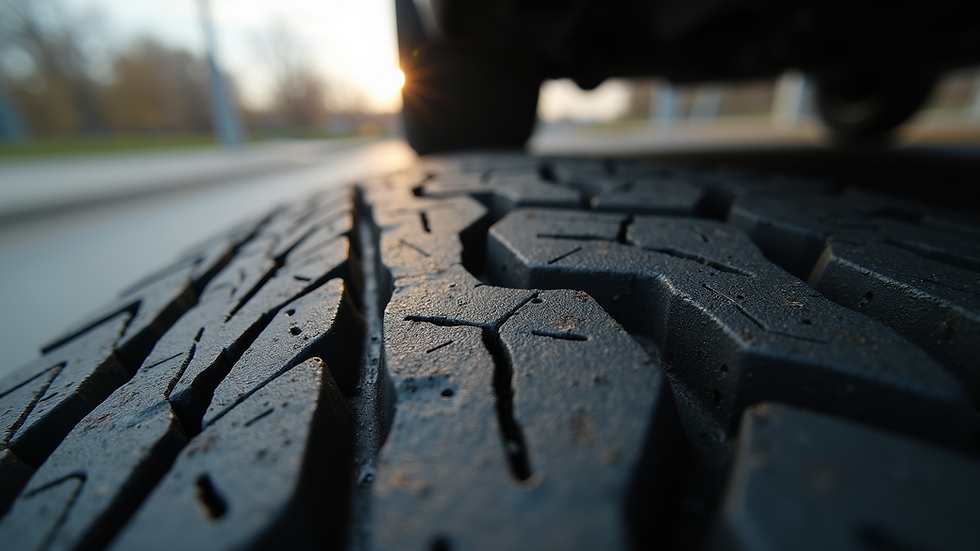Accurate Methods to Check Tire Tread Depth
- mytyre.Store

- Sep 29
- 4 min read
Ensuring your vehicle's tires are in good condition is crucial for safe driving. One of the most important aspects of tire maintenance is monitoring the tread depth. Proper tread depth helps maintain traction, especially on wet or slippery roads, and reduces the risk of accidents. In this article, we will explore accurate methods to check tire tread depth, helping you keep your tires safe and roadworthy.
Why a Tire Tread Check is Essential
Tire tread plays a vital role in vehicle safety. The grooves in the tread channel water away from the tire, preventing hydroplaning and improving grip on the road. As the tread wears down, the tire's ability to perform these functions diminishes. This can lead to longer stopping distances, reduced handling, and increased risk of skidding.
Regular tire tread checks allow you to:
Identify worn tires before they become dangerous
Ensure even tire wear for better performance
Comply with legal tread depth requirements
Save money by replacing tires at the right time
Most countries have legal minimum tread depths, often around 2/32 of an inch (1.6 mm). Driving with tires below this limit can result in fines and increased accident risk.

Close-up view of tire tread grooves showing depth
Simple and Accurate Methods for Tire Tread Check
There are several reliable ways to measure tire tread depth. Some require tools, while others use everyday items. Here are the most effective methods:
1. Using a Tread Depth Gauge
A tread depth gauge is a small, inexpensive tool designed specifically for this purpose. It provides a precise measurement of the tread depth in millimeters or 32nds of an inch.
How to use:
Insert the probe of the gauge into the deepest groove of the tire tread.
Press the base of the gauge flat against the tire.
Read the measurement on the scale.
This method is highly accurate and recommended for regular checks.
2. The Penny Test
If you don't have a tread depth gauge, the penny test is a quick alternative.
How to use:
Take a penny and insert it into the tire tread with Lincoln's head facing down.
If the top of Lincoln's head is visible, the tread is less than 2/32 inch deep and the tire should be replaced.
This test is simple but less precise than a gauge.
3. Using a Quarter for a More Conservative Check
The quarter test is similar to the penny test but uses a quarter coin.
How to use:
Insert a quarter into the tread with Washington's head facing down.
If the tread touches Washington's head, you have at least 4/32 inch of tread remaining, which is safer for wet conditions.
This method helps identify when tires are approaching the minimum safe tread depth.

Eye-level view of a tire with a tread depth gauge inserted
4. Built-in Tread Wear Indicators
Most modern tires have built-in tread wear indicators. These are small raised bars located in the grooves of the tire tread.
How to check:
Look for the indicators in the tread grooves.
When the tread wears down to the level of these bars, it means the tire has reached the minimum safe tread depth and should be replaced.
This method requires no tools but may be harder to see in some lighting conditions.
What does a 2/32 tread look like?
Understanding what a 2/32 inch tread depth looks like can help you visually assess your tires.
At 2/32 inch, the tread is very shallow. The grooves are almost flush with the tread wear indicators. Tires at this depth have significantly reduced grip, especially on wet roads, and are considered unsafe.
If you notice your tire tread looks this worn, it is time to replace the tires immediately to maintain safety.

High angle view of worn tire tread close to 2/32 inch depth
Tips for Maintaining Proper Tire Tread Depth
Maintaining your tires properly can extend their life and keep you safe. Here are some practical tips:
Regularly rotate your tires every 5,000 to 8,000 kilometers to ensure even wear.
Maintain correct tire pressure as per the vehicle manufacturer’s recommendations.
Avoid aggressive driving such as hard braking and fast cornering, which can wear tires faster.
Inspect tires monthly for cuts, punctures, or uneven wear.
Replace tires promptly when tread depth reaches 2/32 inch or if you notice damage.
By following these tips, you can maximize tire performance and safety.
Where to Learn More About Tire Care
For more detailed information on tire maintenance and safety, including checking tire tread depth, you can visit trusted automotive websites or consult your vehicle’s manual. Regular education on tire care helps you make informed decisions and avoid costly mistakes.
Regular tire tread checks are a simple yet vital part of vehicle maintenance. Using the methods described above, you can accurately assess your tire tread depth and ensure your tires are safe for the road. Remember, well-maintained tires not only improve safety but also enhance fuel efficiency and driving comfort. Stay proactive and keep your tires in top condition for every journey.




Comments